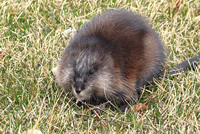Muskrats

Peak Nuisance Period: May through September
Common Nuisance Situations:
- Most muskrat damage is caused by their burrowing.
- They burrow into earthen dams, dikes, levees, and railway embankments, weakening their structures. They also burrow into the banks of ponds, canals, and irrigation and drainage ditches. Their tunnels may drain a small farm pond. They may damage floating docks, marinas, and boathouses.
- Muskrats will cross yards. Some people are frightened of them, or mistake them for Norway rats.
- Occasionally eat field crops. May cause substantial financial losses in states with major rice and aquaculture operations, because they eat rice, cut it down to use as building material for their lodges, and damage the field by burrowing through levees.
- Damage aquaculture sites by burrowing into levees or pond banks.
- Damage ornamental aquatic gardens by eating water lilies or cattails or other plants.
- When their populations grow too high, they may “eat out” all of the aquatic plants in the area, reducing the quality of the habitat for other species, such as waterfowl.
- Disease risks: tularemia, hemorrhagic septicemia, leptospirosis, salmonellosis, ringworm, pseudotuberculosis. They are hosts for many ticks, mites, fleas, and various worms.
Animal Characteristics
Description: Muskrats have fur that is rich brown, dense & glossy with a silver belly. Their tail is long, scaly, blackish & vertically flattened with a tapering point. Their Hindfeet are partially webbed and are larger than the forefeet. Their eyes and ears small. They are excellent, steady swimmers, with head, back, and sculling tail visible. Typical size is 16 to 24 inches and weighs 1.5 lbs to 4 lbs. They are most active at night or near dawn and dusk. They do not hibernate or migrate very far.
Diet:95% aquatic vegetation, but will eat freshwater mussels, frogs, crayfish and fish.
Habitat:Streams, ponds, rivers, canals or lakes, they burrow into the bank with an underwater entrance.
Breeding: 2-3 litters of usually 6-7 young a year April through September.
Mythbusters: N/A
